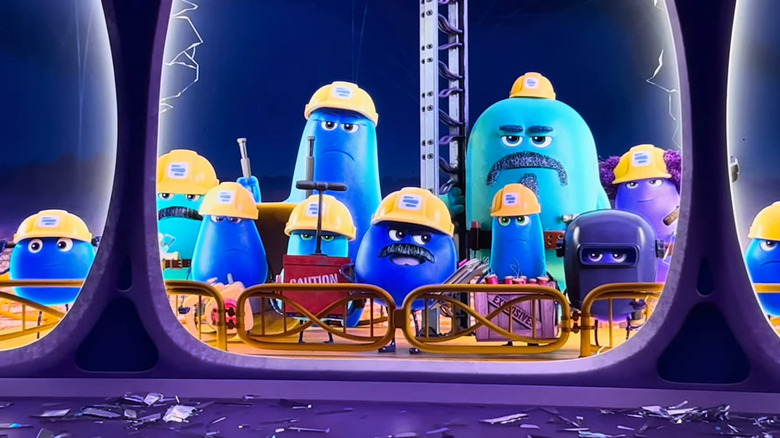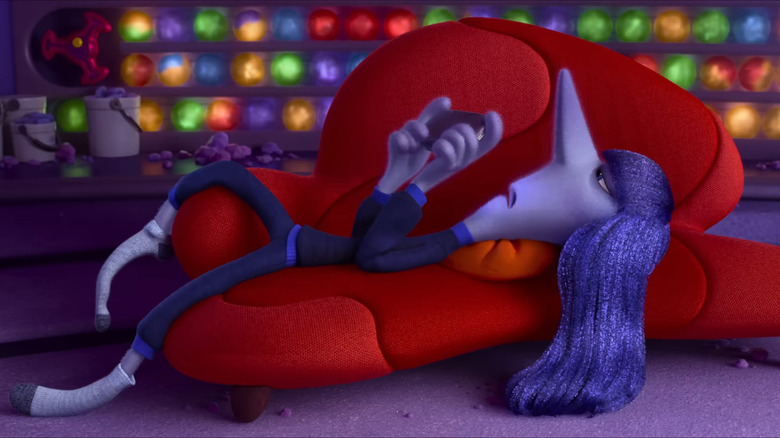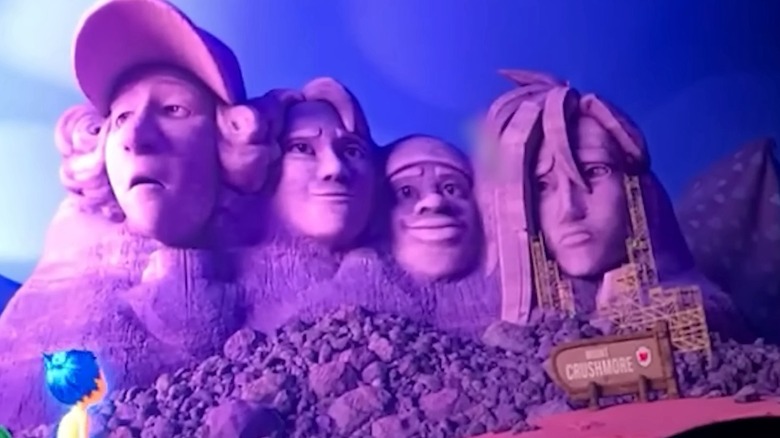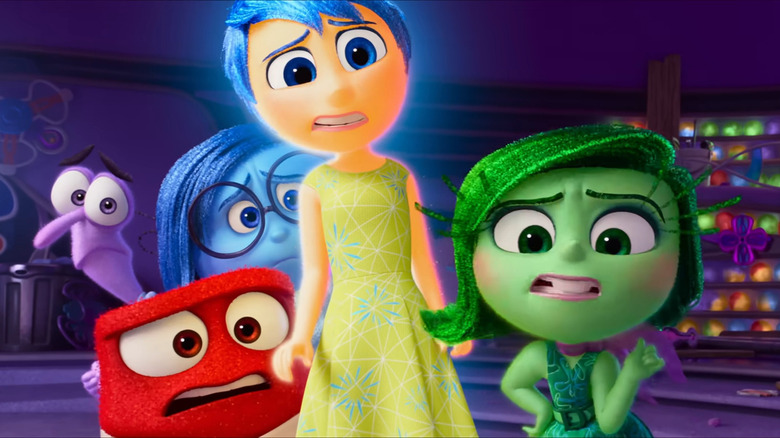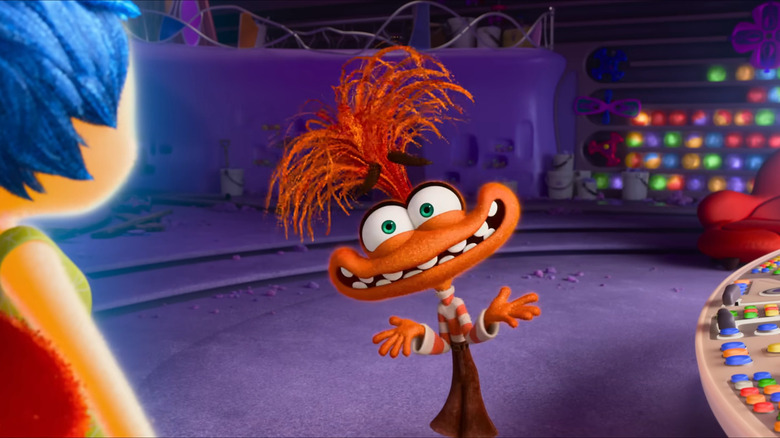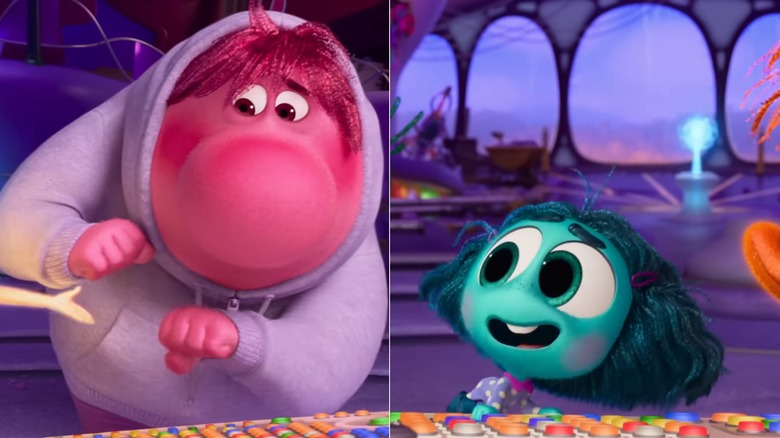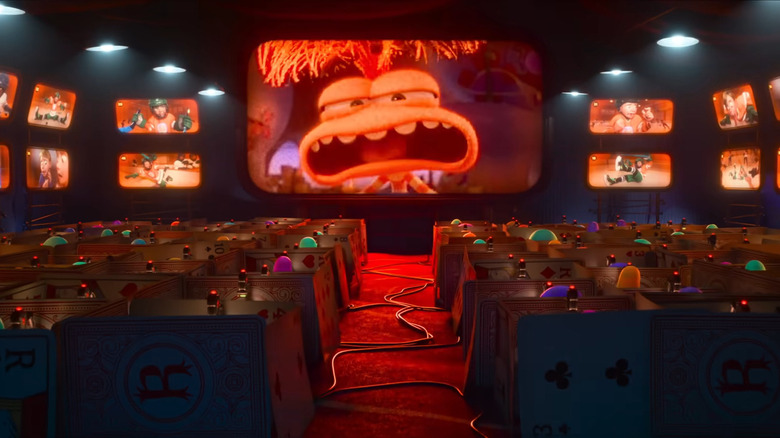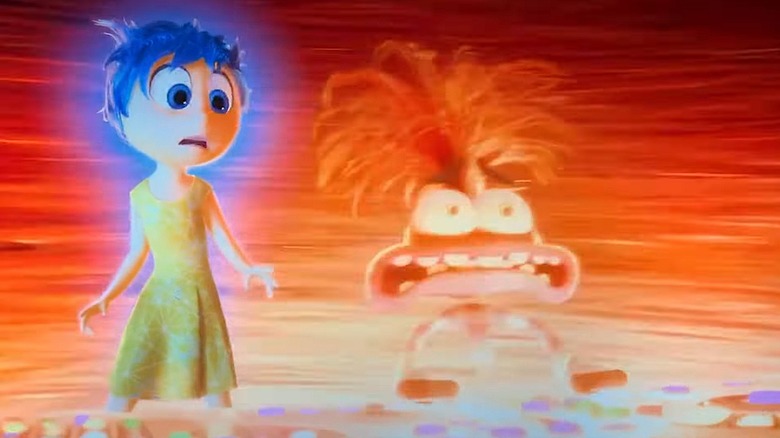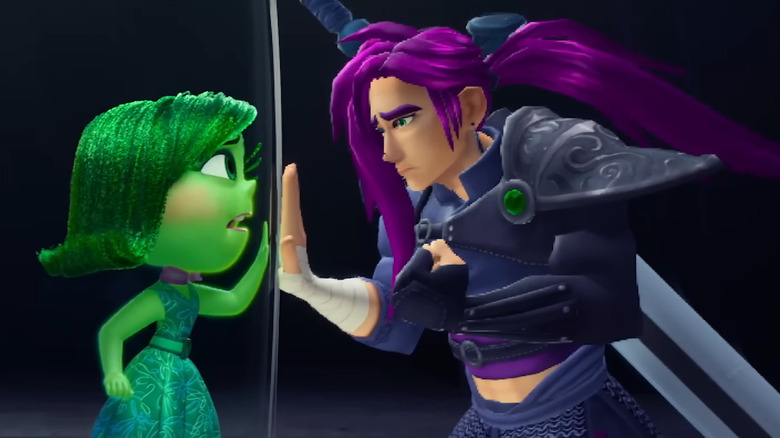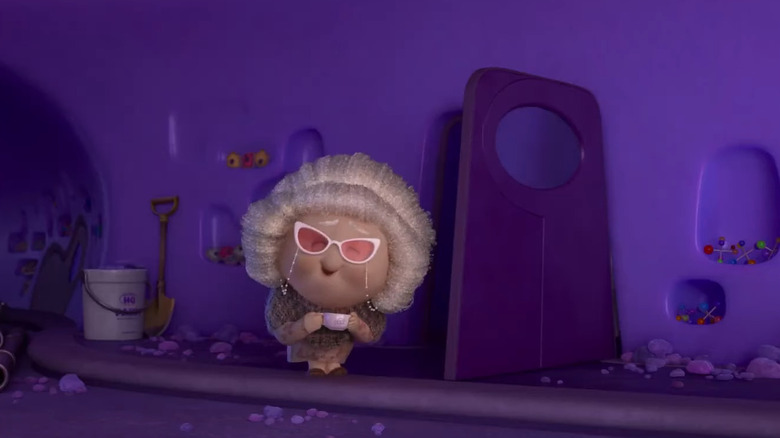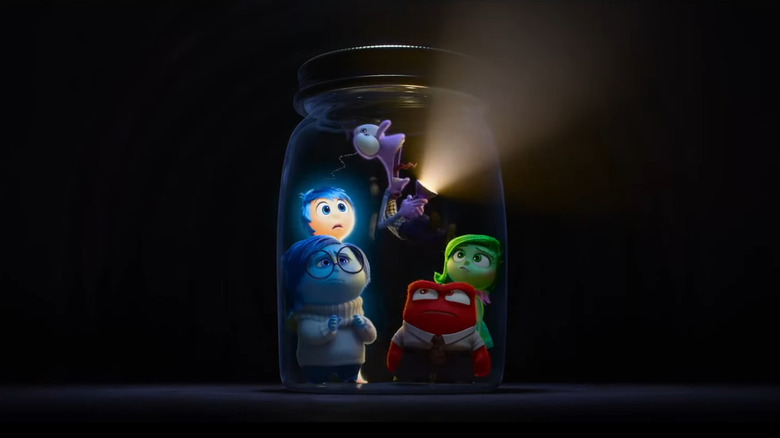Cookies help us deliver our Services. By using our Services, you agree to our use of cookies. Learn More.
Things Only Adults Notice In Inside Out 2
Contains spoilers for “Inside Out 2”
Disney and Pixar’s “Inside Out 2” is a touching and funny coming-of-age film. Like its predecessor, 2015’s “Inside Out,” the movie follows young Riley Andersen (Kensington Tallman) as she navigates a big life change. In “Inside Out 2,” it’s puberty, and the looming threat of Riley and her best friends going to different high schools. It’s a moving, visually delightful reminder that Riley needs a full complement of emotions to be her true self.
The comparatively simple Emotions that piloted kid Riley in “Inside Out” are still led by Joy (Amy Poehler) in “Inside Out 2,” but the sequel introduces new Emotions for Riley’s next phase of life: Anxiety (Maya Hawke) and Envy (Ayo Edebiri) start to have as much influence over Riley as Joy and Sadness (Phyllis Smith), for better or worse. Riley hits puberty with high drama and mood swings perhaps more recognizable to parents and older viewers than most of the movie’s younger audience members.
While it’s very much a child-friendly movie, parts of “Inside Out 2” (which blew everyone away at the box office) will speak to adults in ways that kids won’t get just yet. But which parts of the movie are we talking about, exactly? Here are the things that only grown-ups will notice when watching “Inside Out 2.”
Demo Day as a puberty metaphor
Riley’s Emotions help build her personality in “Inside Out,” but their work is in danger of being totally wiped out in the sequel. Puberty hits Riley like a wrecking ball — literally. A red alarm button blares, and an entire wrecking crew of Mind Workers hits Riley’s emotional scene, smashing through the walls surrounding Joy, Anger (Lewis Black), Fear (Tony Hale), and the other Emotions. The workers refer to this as “Demo Day,” which is presumably short for “Demolition Day” in the world of Riley’s emotions.
While younger viewers might find this funny and drastic, older ones who have lived through the trauma-bomb of puberty will recognize how, seemingly, everything changes overnight. The demolition team clears the way for Riley to go from sweet to sassy and freshly insecure, not to mention super sweaty. Riley is at a loss with her sudden inexplicable mood swings and acts of social desperation, and her parents are blindsided.
Riley’s Mom (Diane Lane) and Dad (Kyle MacLachlan) aren’t in much of “Inside Out 2,” but their scenes showcase the bittersweet nature of watching your child become a teenager. While they try to care for her the best they can, they can’t help but embarrass Riley with their every move. Many adult viewers will no doubt notice that there’s a look of loss on their faces every time Riley snaps at them. Even child-free grown-ups might feel the burn of puberty past while watching Riley. Sure, puberty clears the way for a new self to emerge, but it also leaves so much destruction in its path.
The new Emotions fuel each other
The new crop of Emotions in “Inside Out 2” are all too familiar to adult viewers, even if their appearance may seem hilariously random to kid viewers. Anxiety, Envy, Ennui (Adèle Exarchopoulos), and the mostly-silent Embarrassment (Paul Walter Hauser) take control of Riley when puberty hits. This loss of childhood innocence and wonder, coupled with new senses of panic, shame, and desire, mark a new era of Riley’s development, and of her own self-consciousness.
While these emotions are new for Riley, adults deal with them every day, and sometimes spend a lot of time in therapy trying to escape their iron grip. Adults have lived through puberty and may cringe in recognition of how much they, too, embodied the way-too-cool-for-school Ennui back in their teen years, or their painfully awkward eras personified by Envy and Embarrassment.
Adults will also recognize the relationships the Emotions form with each other: Fear totally has a thing for Anxiety, while Embarrassment and Sadness hit it off right away. Envy and Disgust (Liza Lapira) are two peas in a pod, desperate to preserve their social standing or improve it. These buddied-up emotions are a clever nod to the way our darker instincts can sometimes encourage and feed off each other. To kids, though, these are just a fresh crop of colorful, funny characters.
The Sar-chasm is bittersweet for grown-ups
“Inside Out 2” has a brilliant filmic display of sarcasm entering the chat: The Sar-Chasm. The movie represents Riley’s entry into the use of ironic humor and put-on snarkiness to impress others with a literal chasm. The divide only widens with every eye roll as Riley uses sarcasm while trying to get in good with the older teens on the Fire Hawks hockey team. All words and messages are warped by the Sar-Chasm — even the most friendly of messages comes out rudely on the other side of the divide.
Kids watching the movie may be at the age where they’re just starting to get a taste of their own sense of sarcasm, or a sense of how painful sarcasm can be when it’s pointed at them. Adults, however, know just how much of a communication breakdown the real-life sarcasm chasm can create. Which grown-up among us doesn’t have a painful memory of some snarky kid laughing at one of their jokes, only to immediately cut their laugh short and roll their eyes?
Even adults who love sarcasm themselves will no doubt see the deeper meaning behind the film’s clever chasm: This specific form of detached mockery masks what Riley is really looking for. Sarcasm can cause a rift that blocks genuine connection with others and often leads to hurt feelings, even if it does get a few cheap laughs. Once the Sar-Chasm opens, it can be really hard to bridge the gap.
Mount Crushmore and Friendship Island
The “Inside Out” movies make the intangible world of emotions into a visually stunning and super clever wonderland. Riley’s Islands of Personality are established in “Inside Out,” with each being more or less equal in size. However, in “Inside Out 2,” Riley’s inner landscape has completely shifted. Friendship Island has grown so big that her Family Island can barely be seen. Seriously, Joy needs a pair of binoculars to see it — and those binoculars look suspiciously like Lenny the Binoculars from Disney and Pixar’s smash hit “Toy Story,” a movie that came out back in 1995, when many adult viewers of “Inside Out 2” were kids themselves.
Mount Crushmore also takes up tons of real estate in Riley’s fantasies, or Imagination Land. The crush-worthy carved faces include that of Jordan, a guy Riley might have had a little crush on in “Inside Out” and who she got closer to in the 2015 short “Riley’s First Date?” Kids may or may not pick up on the Mount Rushmore reference, but adults most certainly will. And, while these big internal changes are mostly glossed over by the movie, adults will recognize Riley’s shifting priorities. Even if Riley doesn’t verbalize crushes beyond her obvious interest in the boy band Get up and Glow, she is on the verge of all-new, all-consuming feelings — which, honestly, would make a great premise for a possible “Inside Out 3.”
Rumor Mill tabloids will go over the heads of kids
Gossip flies around Riley’s tweenage mind in “Inside Out 2,” showcasing how new priorities and pressures are changing her life. These whispers of other kids’ social lives and scandals in bloom take the shape of Rumor Mill tabloid newspapers. Joy and the gang of Emotions read some of the gossip news items out loud from the Rumor Mill papers, which are highly recognizable to everyone in the audience old enough to recognize what a paper copy of the National Enquirer looks like.
Framing these rumors as tabloid fodder is yet another cute, effective visual metaphor win for the makers of “Inside Out 2,” one clearly aimed at the grown-ups in the audience. Of course, adults will also recognize the damaging power of rumors and the pressure of being (or not being) the subject of gossip in a more pointed way than the little kids who are watching. But the fact that said rumors are distributed in print rather than on a website or via a TikTok video is for sure something that only adults will notice. News in an actual newspaper — what a concept!
Anxiety’s arc rings true for adults
In “Inside Out,” Riley needed to find a middle ground between Joy and Sadness. There’s a similar balancing act going on in “Inside Out 2,” which shows viewers that while a little Anxiety can be helpful, that emotion should never be allowed to take full control.
The kids in the audience may view Anxiety as a funny, hyper-controlling, all-over-the-place kind of figure, but adults recognize the ebb and flow of Anxiety’s power and panic-inducing qualities through the character’s arc. The creators could have easily made her a flat-out villain, but the fact that the movie shows Anxiety truly trying to be a helpful planner only to become a total control freak will no doubt strike a chord with grown-ups. The fact that the character returns to being a helpful contingency planner who has learned to calm down by drinking a cup of “Anxi-Tea” from time to time is relatable for most adult viewers.
Anxiety’s arc is all about how this emotion can be used as a positive if kept in check. After all, everyone needs a little dose of forward-thinking and concern to get through life. This is a great counterpart to Joy’s realization that Riley may not feel the emotion of joy as much anymore — but she really does want to. Adults in the audience trying to balance everyday worries with everyday wins might find themselves getting hit right in the feels by this.
The deeper meaning of Emo Embarrassment and Little Envy
A lot goes into the design of the Emotions, and much of this work is only recognizable to adults. For example, Embarrassment’s styling as an emo kid is beyond perfection and a total shoutout to the elder millennials watching “Inside Out 2.” The gentle giant’s emotional support hoodie, hunched posture, general silence, and just-barely-visible plumber’s crack is straight out of an early 2000s emo lineup. If Embarrassment was able to verbalize his feelings a little more, he would probably end up as the lead singer in a band. Elsewhere, kids may notice that Envy is an adorable little pipsqueak of an Emotion, but adults will understand just why such a big Emotion comes in a small package.
Envy is an emotion that makes people feel, well, small. Focusing on what others have, especially if it’s an obsession over what you lack, inevitably leads to feeling ignored, ineffective, and teensy-weensy. Envy’s tiny tot stature is misleading, and that’s on purpose. What can start as a small streak of jealousy can often build into an all-consuming emotion, which pretty much every adult has experienced if they’re honest with themselves. Adults will also recognize Envy’s manic energy and narrow focus — jealousy makes the world very small and dull, even if the Envy in “Inside Out 2” is also funny and adorable.
Anxiety’s 1984 Apple commercial send-up
In a perfectly tense and hilarious sequence, Joy frees Riley’s dreams from Anxiety’s panic projections. Anxiety has commandeered Riley’s imagination and is only sending negative projections to her brain, keeping Riley from sleep. The tween protagonist is thrown into a state of insomnia as she worries over what to do to impress her new friends at hockey camp. Lots of little Mind Workers draw terror scenarios instead of sweet dreams for Riley, bidden to do so by Anxiety, who speaks to her newfound underlings via a giant screen surrounded by smaller screens playing the bad dream projections.
This sequence takes heavy inspiration from an iconic Apple commercial called “1984,” directed by Ridley Scott. The ad is inspired by George Orwell’s dystopian novel of the same name, about life under oppressive overlords. Many adults in the audience will have seen this ad, whether at the time or on YouTube years later, seeing as it’s usually part of all-time best Super Bowl commercial collections. Also, a lot of grown-ups will be aware of this fun fact: Steve Jobs played a big part in making Pixar what it is today. As such, this part of the film is both a cute, corporate full-circle moment and a deliciously Orwellian nod.
Anxiety’s big panic attack
Anxiety’s big panic attack in the final act of “Inside Out 2” is one of the movie’s scariest moments. She loses control and tailspins into a frenzy by refusing to let anyone help her, instead downing multiple energy drinks at once. Adults in the audience will know that power-chugging caffeine, while a natural response to panic, really only throws fuel on the panic-attack fire. This moment becomes a stunning (and terrifying) visual representation of an anxiety attack.
Anxiety’s “reasonable” plans lead to her being helplessly glued to Riley’s emotional console. She phases in and out of her body. Her eyes well with tears. Anxiety’s own manic actions turn into a cyclone of orange light and worry. She can’t stop herself or break the panic until Joy literally pulls Anxiety’s hands from the console. Any adult who has suffered an anxiety attack or lives with a panic disorder can recognize this terrible feeling for what it is, even without the visual intercuts of Riley sweating and feeling short of breath. “Inside Out 2” puts a face on the feeling, perfectly encapsulating the destructive, cyclical power of a panic attack.
Lance Slashblade is from a bygone era of video games
Lance Slashblade (Yong Yea) is one of Riley’s secret crushes. The Emotions discover him when they are temporarily locked away in a vault. While younger viewers might wonder why he looks kind of funny compared to the other characters, his basic design (Lance is animated with polygonal graphics) is because he’s a video game character from yesteryear.
Today’s video game characters look almost real compared to the ones featured in the games that the adults watching the film played as children. Lance is straight out of the sixth generation of video game consoles — we’re talking PlayStation 2, the first XBox, the GameCube, and the Dreamcast. His appearance and persona no doubt provided a hit of nostalgia for millennial adults in the audience.
Lance probably reminds many adult viewers of their own youthful video game crushes, particularly those who played the “Final Fantasy” series — he bears a striking resemblance to Cloud Strife, the main protagonist of “Final Fantasy VII,” “Final Fantasy VII Remake,” “Final Fantasy VII Rebirth,” and “Final Fantasy VII: Advent Children.” His wild hair and comically oversized weapon also give major Cloud vibes. While he’s one of Riley’s crushes, Lance ends up becoming the love interest of Disgust in one of the movie’s funniest storylines.
Nostalgia is depicted perfectly
Nostalgia (June Squibb) takes the form of a little old reminiscing lady in “Inside Out 2”, which is a great visual representation of the looking-back-fondly Emotion: Nothing makes us feel old like recalling the good old days. Kids may not fully understand why Nostalgia “isn’t supposed to be here yet,” as Joy points out (Riley is still just a child, after all) but the adults will. While tweens and teens have fond memories just like adults do, so much in their young lives is changing. They may want to recall something for a moment, but adults can sometimes be powered by Nostalgia, because they’re in a different stage of life.
Another thing adults will notice about Nostalgia, aside from her being a bit early for Riley, is that she always seems to pop up out of nowhere, just like nostalgia does in real life. A certain scent or note of a song can immediately transport grownups to another, earlier time in their life. In a nice touch that probably went over the heads of the kids in the audience, the creators made the lenses of Nostalgia’s glasses pink. This is clearly a nod to the saying “rose tinted glasses,” which means seeing something in a more positive light than it maybe deserves. This is very much in line with nostalgia — we sometimes only remember the good things about a certain time or a certain person.
Riley’s Deep Dark Secret
Riley’s Deep Dark Secret (Steve Purcell) isn’t actually all that deep or dark, even though it desperately wants to stay in hiding, even at the very end of “Inside Out 2.” The Secret crawls back into the vault prison that Joy and the other Emotions worked so hard to escape, despite being given the chance to roam free. Adults may recognize that what someone thinks is a terrible secret worthy of hiding away might not actually be so terrible when brought to light. Adults may also roll their eyes at Riley’s Deep Dark Secret. The movie builds it up intensely, only for the payoff to be somewhat underwhelming.
Maybe this Emotion (or aspect of emotion) is meant to be a container for secrets that will grow and change as Riley does. After all, one life phase’s burned rug can become another life phase’s deep shame, rooted in more consequential actions. Of course, adults and kids alike will be aware that keeping a secret buried deep down inside you can cause some emotional strain. Adults, however, will be aware that the Secret needs coaching and encouragement — like that given by Joy — to even think about making itself known. The truth can be scary, but the relief that comes with sharing it can be cathartic.



